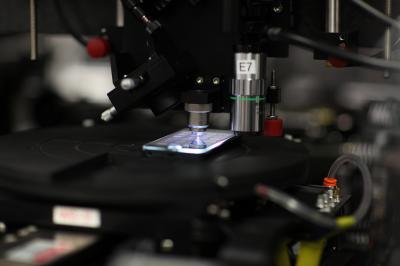Researchers from Montreal have teamed up with New York company Corning Incorporated to create the first laser-written guiding systems that can be used commercially within your smartphones.
 An invisible waveguide (pathway for light) being written via laser
An invisible waveguide (pathway for light) being written via laser
into a smartphone's display glass.
(Image via Optics Express)
What does this mean for us consumers?
This kind of technology could allow future smartphones to come equipped with sensors that are embedded directly into layers of the glass.
For example, sensors that can take your temperature or even monitor your blood sugar levels can be placed within your phone’s display.
The researchers have used this technology to build two types of transparent systems- a temperature sensors and a new system for authenticating a smartphone using infrared light.
They built these two systems into the glass similar to the one on your smartphone.
Not only is the team thinking of this technology for biomedical smartphone purposes but also for computing devices that could be embedded into any glass surface (like a window) to create transparent surfaces like we see in the movies.
How they did it
The researchers employed the power of photonics in which electronic devices transmit information using infrared light.
They used lasers to carve out transparent pathways called waveguides onto the glass (as seen in the image above).
 This is a photograph of the laser writing setup.
This is a photograph of the laser writing setup.
(Image via Jerome Lapointe)
The waveguides act as tunnels that channel light, just like electronic lines transfer electrical signals.
This is the first time any group has applied this technique to Gorilla Glass, a tough glass developed by corning and now used in billions of electronic devices.
In order to demonstrate the technology the team built a temperature sensor that could change the path length of a waveguide and measured how the light that emerges from one waveguide interferes with light from the other, in effect measuring temperature.
They also developed a new method for authenticating a smartphone based on waveguides with holes at various locations. The light that escapes through those holes creates a pattern that is unique to their arrangement. Each phone would have its own unique pattern, like a fingerprint, which could then be read by an infrared detector to confirm the identity of the phone as an additional layer of security for making financial transactions using smartphones. Such transactions could be safe because instead of using radio frequency they use infrared light, which is blocked by most materials and therefore cannot be copied through a pocket or purse.
Both of these systems are awaiting patent approval and could find their way into your electronics.
For more information view the full paper “Making Smart Phones Smarter with Photonics.”
Advertisement
Learn more about Electronic Products Magazine





